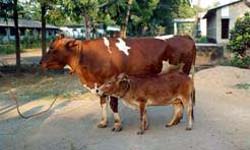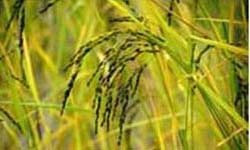You are here :
Home Indegenous variety of Kerala
|
Last Updated:: 02/03/2024
Indegenous variety of Kerala
Vechur cow

Vechur cow got its ancient name from the village where it is supposed to have evolved. Kerala, a narrow strip of land comprising hills and valleys between the Western Ghats and the Arabian Sea , had a large number of dwarf cattle. The local people had distinguished the Vechur cattle from others by certain well-defined, inheritable characteristics. They apparently preserved the purity of the breed by selective breeding. They are extremely small size,have low feed requirements, high disease resistant . The dwarf cattle were well adapted for the hot, humid tropical climate of Kerala. Vechur bulls, though small in size (maximum height at hump level 105 cms), were very strong and these lightweight animals were used for ploughing marshy paddy fields typical of Kerala. The Vechur cow has international recognition and attention .The Food and Agriculture Organisation (FAO) has listed the Vechur cattle among the Indian breeds in their Domestic Animal Diversity Information System. The World Watch List of Domestic Animal Diversity, also published by the FAO, has listed the Vechur cattle under the category of Critical Breeds, meaning nearly extinct. The Vechoor cow, credited to having the highest milk yield, calculated in proportion to its body weight and very low feed requirments, is listed as a 'distinct breed' among the 30 breeds of Indian cattle under the ICAR's latest calendar on 'cattle breeds of India ' published by the National Bureau of Animal Genetic Resources.
Scientists at the College of Veterinary and Animal Sciences (COVAS), Mannuthy, Thrissur, affiliated to Kerala Agricultural University (KAU), have achieved a remarkable feat by isolating, cloning and sequencing Alpha lactalbumin gene of the Vechur cow. This was for the first time that the alpha lactalbumin gene of any Indian cattle breed had been isolated and fully sequenced. Sequencing of the gene helps study the functioning of the gene. This alpha lactalbumin gene has 1756 base pairs, and has promoter and other regulatory sequences.The gene's promoter helps expression of the gene, which in this case is the synthesis of the protein. This gene produces alpha lactalbumin in cow's milk, and, therefore, is an important protein on nutritional angle.
The credit of saving the Vechur cattle from the brink of extinction goes to a conservation programme undertaken by the Kerala Agriculture University (KAU). Had the programme been delayed for a few years, the Vechur cattle would have now been listed among the extinct animals. Subsequent to the studies conducted by the KAU, the Vechur cattle are now recognised as the smallest cattle in the world. The maximum height of a Vechur cow is 91 cms. This diminutive cow, weighing on an average 107 kgs. can give an average yield of 3 litres of milk per day . Proportionate to its body weight, the Vechur cow yields maximum milk in the world. Accordingly, the Vechoor Cow Conservation Project was started in 1990 by the University with the assistance of the Indian Council of Agricultural Research (ICAR). At present, a nucleus stock of about 135 cows and bulls having a maximum hump level height of 105 cms and weighing an average 107 kg, are thriving at the University's cattle farm here.
The percentage of fat and total solids in the milk of Vechur cows is higher compared to crossbred cows. But a more significant aspect is the size of the fat globules. The mean size of fat globule in the milk of the Vechur cow (3.21 microns) is higher than that of the goat (2.60 microns), but considerably smaller than that of the crossbred cows (4.87 microns) and of Murrah buffalo (5.85 microns). The small size of fat globules means high phospholipid content because of greater surface area. Phospholipids are important in the development of brain and nerve tissues and also play a vital role in the absorption and digestion of fat
Njavara rice

Njavara is a rice variety endemic to Kerala, mainly seen in the northern parts. The cultivation of this rice variety is recorded from 2500 years back. It is a unique grain plant in the Oryza group and is known as Sasthikasali (Sasthika -60 day; Sali -White rice) due to its extra short requirement of just 60 days to grow and mature. `Ashtanga Hridaya' (Vagabhata, 500 BC) described two types of Njavara - black and white, of which the later is superior. But the yield and quality of Njavara vary with the location. Due to many reasons this species is in the verge of extinction. This is the only cultivar traditionally used effectively in the Ayurvedic system of medicine in certain specific treatments like Panchakarma.
Molecular studies conducted by a team of scientists from the Kerala Agricultural University (KAU) on ‘Njavara' rice have indicated the presence of a gene fragment encoding a protein which is reported to have anti-carcinogenic (chemo-preventive) property, especially against breast cancer. This protein, christened Bowman-Birk Trypsin Inhibitor protein, is also known to possess anti-inflammatory and anti-allergic properties in animals and is reported to be capable of imparting resistance to fungal pathogens and pests in crops. The KAU scientists pointed out that traditionally njavara was used in the ayurveda system of medicine for treatment of neurological disorders, rheumatism, arthritis and emaciation of limbs. Porridge of njavara grains in milk was traditionally being given as special food for invalids and infants.